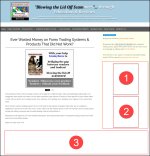Position Sizing Methods / Money Management Models
Below are the more popular position sizing methods / money management models;
Fixed Units
This is the simplest of all the position sizing methods. Regardless of your current account balance, always enter x amount of units per position. Example; enter trade with 30,000 units every time.
Fixed sum
A dollar amount is established which will be used for each and every trade. The number of units is determined by dividing the price of the currency into the desired position size. Example; We want to trade $40,000 worth of currency per position. We divide 1.4857 into $40,000 thereby giving us 26,923 units to enter the position with. In time, when we are ready to enter our next position the price may be 1.4935. We then divide 1.4935 into $40,000 to provide us with an entry of 26,782 units.
% of capital
This method lets you scale position sizes based on changes to the overall Capital. You specify a percentage of available Capital that each position should take. This strategy allows for a geometric growth of capital because the size of your position grows in relation to the equity growth in your account. If you would like to trade more aggressively, you should increase the % of Capital to invest. The larger the percentage, the more potential profit as well as potential risk. More conservative investors may choose a smaller % of Capital.
Number_of_units = (Current_Capital * %_of_Capital * Margin provided) / Unit_Price
Example;
% of capital – 10% Margin % 200:1 Unit price 1.3436 Current capital $10,000
In this case you would buy (10,000*1.3436*200) / 10 = 268,720 units or $200,000 worth of currency.
Fixed Risk
The idea behind fixed risk or fixed fractional position sizing method is that the number units is based on the risk of the trade. The risk is the same percentage or fraction of account equity on each trade. For example, you might risk 3% of your account equity on each trade. Fixed risk / fractional position sizing has been written about extensively by Ralph Vince. See, for example, his book "Portfolio Management Formulas," John Wiley & Sons, New York, 1990.
The risk of a trade is defined as the dollar amount that the trade would lose per unit if it were a loss. Commonly, the trade risk is taken as the size of the money management stop applied, if any, to each trade. If your system doesn’t use protective (money management) stops, the trade risk can be taken as the largest historical loss per unit. This was the approach Vince adopted in his book Portfolio Management Formulas.
Example; Our trading strategy / system uses a 200 pip stop loss. Our account size balance is $10,600. Therefore 3% of $10,600 = $318. Risk on the next trade would be limited to $318. We can purchase 15,900 units. If our system stop loss was 100 pips we could purchase 31,800 units. (31,800 units translates to 0.3 standard lots or 3 mini lots or 31 micro lots).
Fixed risk position sizing is one of the only position sizing methods that directly incorporates the trade risk (also see the Profit Risk method below).
Profit Risk Method
The profit risk position sizing method is similar to fixed risk / fractional position sizing. In fixed risk position sizing, the dollar amount risked on a trade is a percentage of the current account equity. In the profit risk method, the dollar amount risked on a trade is a percentage of the starting account equity plus a percentage of the total closed trade profit. Once the risk amount is determined, the number of units is calculated the same way as in fixed risk trading; namely, the amount to be risked is divided by the trade risk per unit. As an example, consider a trade where the risk of the upcoming trade is $300 per unit. This amount might correspond to the size of the money management stop that will be used during the trade or it might be the largest loss per unit that the trading method has ever produced. Now suppose that the trading account started with a balance of $25,000 and is currently at a value of $45,000 (a total closed trade profit of $20,000). The percentages for the profit risk method might be 2% of initial equity and 5% of profits. This means that the total amount to risk on the trade would be 0.02 x 25000 + 0.05 x 20000 or $1,500. Since the trade risk is $300 per unit, the number of units to trade is 1500/300 or 5 units. Compared to fixed risk position sizing, the profit risk method is sometimes more convenient because it separates the account equity into initial equity and closed trade profit. The percentage applied to the initial equity provides a baseline level of position sizing independent of trading profits. Note that if both percentages are the same, the profit risk method will produce the same result as the fixed risk method.
Kelly Formula
The Kelly formula is a specialized form of fixed fractional position sizing methods, described below, which uses an approximate formula – the Kelly formula – to determine the fixed fraction that maximizes the equity growth rate. Fixed fractional position sizing risks a specified fraction of account equity on each trade. The Kelly formula specifies a particular value of the fixed fraction. This “Kelly f value” is given by the following equation: Fk = ((WL + 1) * Pw – 1)/WL where WL is the ratio of the average winning trade to the average losing trade and Pw is the probability of a winning trade. For example, if the average winning trade is $300, the average losing trade is $400, and the percentage of winning trades is 65%, the Kelly f value would be ((0.75 + 1) * .65 – 1)/0.75 or 0.183. This means that 18.3% of the account would be risked on each trade. To determine the position size, the trade risk is assumed to be equal to the largest historical loss. For example, if the largest loss experienced by the system in question was $1,200 trading one unit, and the account equity was $35,000, then 18.3% of $35,000 is $6,405. This is the amount to risk on the trade according to the Kelly formula. With a trade risk of $1,200, this means we can trade 6405/1200 or 5 units. Please note the following:
1. The Kelly formula is approximate in that it assumes all wins
are the same size and all losses are the same size. The optimal f
method, described below, removes this assumption.
2.The formula does not take equity drawdowns into account and may
produce very large drawdowns in equity. In many cases, the position
size will be limited by margin requirements when using the Kelly
formula.
3.The Kelly formula is not generally considered to be a practical or viable method of position sizing and is only included for comparison to other methods and for educational purposes.
During his record-breaking trading Larry Williams used the Kelly's formula position sizing method where the starting risk was defined by the size of the margin per futures contract. Thorpe recommends using % of risk within 0.5 * Kelly <= % risk < Kelly bounds.
Optimal f
Like the Kelly formula, optimal f position sizing method is a
specialized form of fixed fractional (fixed risk) position sizing.
Optimal f position sizing method uses the fixed fraction that maximizes
the geometric rate of equity growth. This method was developed by Ralph
Vince as a more accurate version of the Kelly formula. Unfortunately,
optimal f has many of the same drawbacks as the Kelly formula. Namely,
the optimal f value often results in drawdowns that are too large for
most traders to tolerate. As with the Kelly formula, the position size
based on the optimal f is often so high that it’s limited by margin
requirements.
The optimal f value is calculated according to an iterative procedure that maximizes the geometric growth rate for the current sequence of trades. The calculation for the position size is the same as for the Kelly formula except that the optimal f value is used in place of the Kelly f value. The trade risk is taken as the largest historical loss per unit. As with the Kelly formula, optimal f position sizing is included primarily for educational purposes.
secure f
Leo Zamansky and David Stendahl tried to overcome large drawdowns Optimal f by adding a special limit of maximall allowable drawdown. Secure F solves a task :
Net Profit -> Max (similarly Optimal f) under condition Max_Drawdown <= Max_Allowed_Drawdown.
The difference between the Secure F and the Optimal f position sizing methods is that in case of Secure F the drawdown will be taken into account. Value of Secure F can never be higher that the value of Optimal f.
Number_of_units = (Secure_F * Current_Capital / starting_risk_per_unity_of_assets)/Security_Price
where starting risk = maximal loss at trade(in %). Example:
Current Capital - $2,000,000 ($10,000 with margin factor of 200).
Currency Price – 1.2785
Max DrawDown - 20% (value of maximal allowed DrawDown)
Secure F - 0.10 (value of maximal allowed DrawDown)
Maximal Loss at trade - 50%
In this case you can buy (0.1 * 2,000,000/0.5)/1.2785 = 312,867/50 = 156,433 units.($200,000)
Summary
If you understand the basics of most of the position sizing methods mentioned above, then that will go a long way in helping to grow your account steadily and with reduced risk.
It is important to note that if you are confused by some of the
more complex formula's on some of the position sizing methods do not be
concerned. With the advent of money management software, these programs
will take the hard work out from choosing which method to apply. Most of
the good money management software will be able to recommend which
position sizing method will produce the best result according to the
parameters of your own trading system.
Read about the Ralph Vincent experiment and learn more about the importance of money management here.





